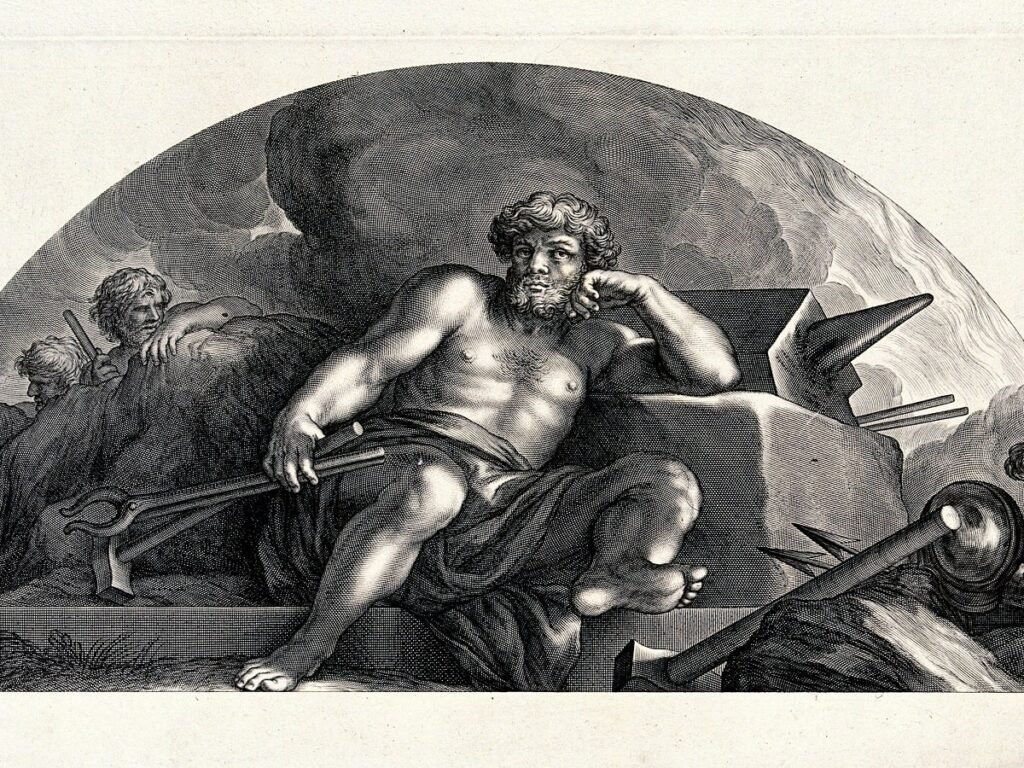In Greek mythology, Hephaestus was a prominent god associated with fire and craftsmanship. He was highly revered for his exceptional blacksmithing skills and renowned creations. This article will delve into the various aspects of Hephaestus’ life, his significance in Greek mythology, his skills and creations, and his relationships and depictions in art.
Hephaestus in Greek Mythology
Hephaestus, also known as Vulcan in Roman mythology, held a significant place in Greek mythology. He was the son of Zeus and Hera, although his birth story varies among different myths. According to one version, Hephaestus was born from Hera alone, while in another version, he was conceived by both Zeus and Hera.
However, Hephaestus’ life was not without hardships. He was cast out of heaven twice. The first time, his mother Hera, dissatisfied with his deformities, hurled him off Mount Olympus out of shame. Hephaestus fell for an entire day and night before finally landing on the island of Lemnos.
During his exile on Lemnos, Hephaestus honed his craft and created remarkable inventions. Eventually, he was brought back to Olympus by Dionysus, who lured him with wine. Hephaestus agreed to return to the divine realm, bringing along his exceptional skills and craftsmanship.
Hephaestus’ worship was particularly prominent in Asia Minor, with Lemnos being one of the main centers of his cult. The island of Lemnos held a special place for Hephaestus, as it was his first refuge after being cast out of Olympus. Temples dedicated to Hephaestus were built in Lemnos and neighboring islands, including Samothrace and Thasos. Additionally, he was also worshipped at Lycian Olympus.
His cult eventually spread to Athens around 600 BCE, where he was celebrated as the patron god of blacksmiths and craftsmen. The popularity of his worship continued to grow, eventually reaching Campania in Italy.
Hephaestus’ Skills and Creations
Blacksmith and Craftsman Extraordinaire
Hephaestus was renowned for his exceptional blacksmithing skills and craftsmanship. He was considered the supreme blacksmith of the gods, and his creations were unmatched in their beauty and functionality. His workshops were said to be located beneath volcanoes, associating him with volcanic and gaseous fires.
One of Hephaestus’ roles was creating weapons and military equipment for both the gods and mortals. His weapons were said to possess immense power and were often imbued with divine enchantments. He crafted weapons such as Zeus’ thunderbolts and Achilles’ armor, showcasing his masterful craftsmanship.
Exemplary Creations
Hephaestus’ creations were not limited to weapons alone. He crafted remarkable artifacts that served the gods and mortals in various ways. One notable creation was the winged helmet and sandals he made for Hermes, the messenger of the gods. These items endowed Hermes with incredible speed and agility.
Another exemplar creation by Hephaestus was the Aegis, a shield adorned with the head of the Gorgon Medusa. This shield was carried by Athena, the goddess of wisdom and warfare, and it possessed the power to terrify enemies and protect its bearer.
Relationships and Depictions of Hephaestus
The Marriage to Aphrodite
One of the most well-known aspects of Hephaestus’ life is his marriage to Aphrodite, the goddess of love and beauty. Despite his physical deformities, Hephaestus won Aphrodite’s heart and married her. Their marriage was seen as an allegory of love transcending physical appearances. Hephaestus’ skills as a blacksmith served as a testament to his desirable qualities beyond his appearance.
Their union, however, was not without challenges. Aphrodite had several affairs with other gods and mortals, causing emotional pain for Hephaestus. Nevertheless, he remained steadfast and dedicated to his craft, finding solace in his work.
A Different Perspective
It is worth noting that in the Iliad, Homer presents a different perspective regarding Hephaestus’ relationship status. In one passage, Hephaestus is mentioned as married to Charis, one of the Graces and daughters of Zeus and Hera, and not Aphrodite. Though Hephaestus’ marriage to Aphrodite is widely known, the mention of Charis adds further complexity to his relationships within Greek mythology.
Depictions in Art
Hephaestus is often depicted as a middle-aged bearded man in art. The beard symbolizes his maturity, wisdom, and experience as a master craftsman. Occasionally, Hephaestus is portrayed as a younger, beardless version, emphasizing his association with youth and creativity.
In terms of attire, Hephaestus is typically depicted wearing a short sleeveless tunic and a round, close-fitting cap, known as a pilos. This attire highlights his role as a blacksmith and craftsman, allowing for easy movement and protection from sparks. Sometimes, he is shown carrying a hammer or a pair of tongs, emphasizing his association with his craft.
Conclusion
In conclusion, Hephaestus was an exceptional blacksmith deity in Greek mythology. Despite being cast out of heaven twice, he rose above his difficulties and became revered for his unparalleled craftsmanship. His creations, ranging from powerful weapons to ingenious artifacts, showcased his skill and artistry. Hephaestus’ relationships with Aphrodite and Charis added depth to his character within Greek mythology. Portrayed with a mature bearded appearance or a youthful depiction, Hephaestus’ influence and importance continue to be acknowledged in art and culture.
